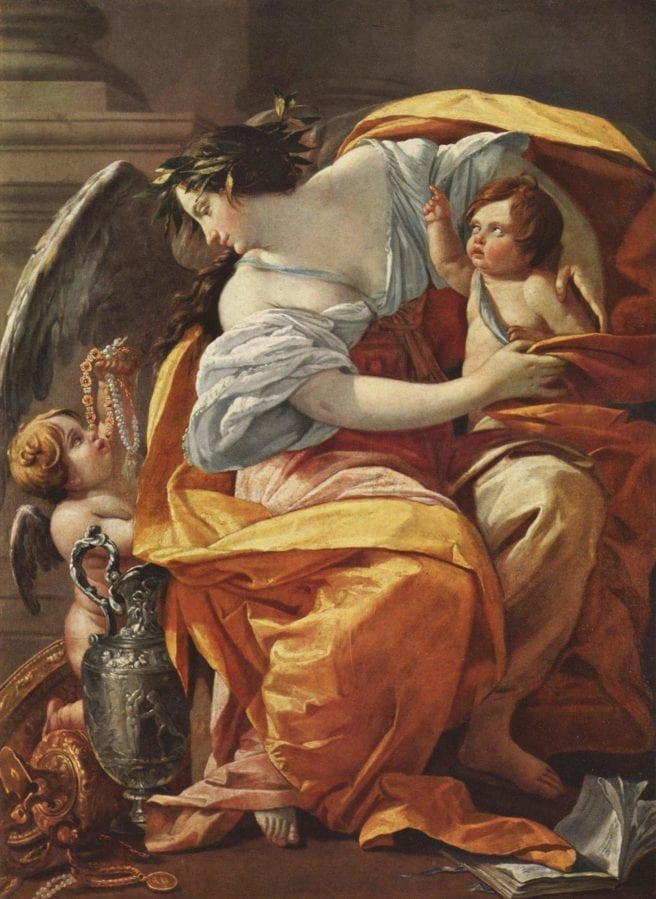Allegories bring big ideas down to earth. Simon Vouet’s Wealth painting gives a grand example of this at work. Baroque painters, such as Vouet, reveled in allegory. They swam in it, like Scrooge McDuck with his pool of gold coins. Vouet flourishes with wealth as a sweep of golden fabric across the work’s center – a rich beacon.
Prefer listening to reading? Click the link below for this podcast.
Allegory of Wealth painting shows a woman surrounded with children beside her here. That’s to remind us that it’s not the bejeweled necklaces and chic vases that matter most. True riches lie in bonds of the heart and soul. For instance, with the unconditional love between parent and child depicted here. Our woman in the the painting drowns in riches. She’s got it on all levels, tangible, emotional, and familial.
That’s why Vouet depicts our lady Wealth’s eyes locked into those of the cherubic child. It’s where her focus lies, in this love rather than her gold. The painter expounds on Wealth’s meaning with this detail at the center of the work. Just in case we miss it, though, Vouet puts another angelic child beside her. This one points to her head as if telling us where to look. The mother in our Allegory of Wealth clutches this infant harbinger to her chest. She appreciates this child’s love. Wealth holds the baby close; not the necklaces or golden urn.
Still, her tangible riches make it easier for her to care for others. That familiar phrase “share the wealth” refers to this kind of healthy generosity shown in Allegory of Wealth. We see it can be generous. She’s got it to give here. There’s great joy in this. In fact, the ability to help others may be the greatest gift of all in life. It satisfies more than a Las Vegas buffet. Vouet uses her parental manner to show this. But it applies to all forms of unconditional love and generosity. Often, it’s the giver who actually gets the most out of it.
Allegory of Wealth Elevates Art & Literature
We all have our choice indulgences. For some it’s chocolate or booze. Others enjoy travel. For the Allegory of Wealth in this painting, “finer things” means art and literature. The urns at her side and imposing pillars behind her signify art. Her eyes may be elsewhere. But she surrounds herself with fine creations. It’s no wonder. Wealth can afford it.
It’s a luxurious portrait. The triumphant laurel wreath to the gold silk show her glory. She’s drowning in riches from crown to pointed toe. In fact, this lady’s set. One of her cherubs holds fine jewelry up to her. But our fine lady looks past them into the angel’s eyes. Who needs gems when you’re loaded like this?
She’s also in the middle of an engrossing book. We know this because our lucky lady in the Allegory of Wealth points her toe to this open opus – ready to turn the page. The wonder of reading a fantastic book offers another kind of wealth. It transports us. Vouet offers these symbols for a reason. He wants us to absorb these ideals. After all, allegories often illustrate morality and values. Through this Allegory of Wealth we can see what mattered to either Vouet or this work’s commissioner.
Simon Vouet’s Allegory of Wealth – Factoids
- French painter Simon Vouet was born January 9, 1590.
- As we see in Allegory of Wealth, he primarily painted in Italianate Baroque style.
- Simon was the most eminent French painter of the 1630s and even into the early 1640s.
- In fact, he introduced this style with paintings like this Allegory of Wealth to the French art world.
- Vouet’s success far eclipsed his artist father’s career.
- The signs were already apparent when Simon was a child. He painted coveted portraits at only 14 years old.
- Vouet also painted many beloved religious paintings. This includes the glorious Martyrdom of Saint Eustace.
ENJOYED THIS Allegory of Wealth ANALYSIS?
Check out these other essays on French Painters.
